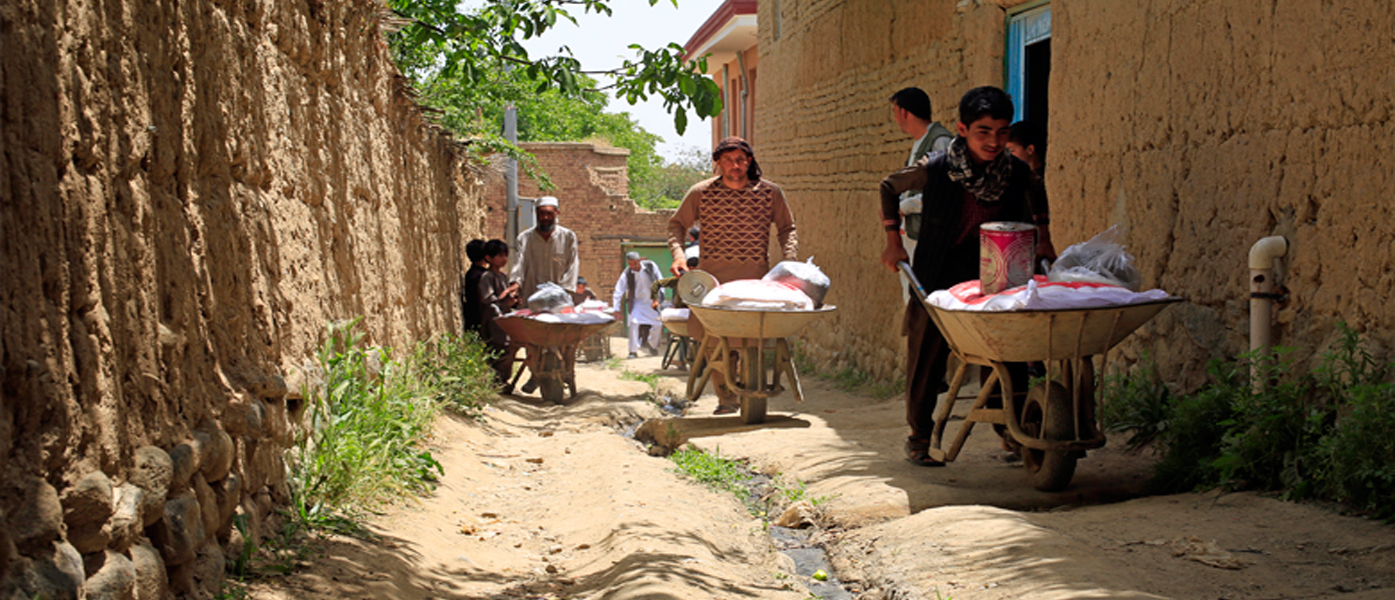
Community Grain Bank Staves off Hunger in Food Insecure Households
Story Highlights
- Food insecure households in a district in Kabul Province have found relief in community grain banks, which are being set up across the country.
- Over 4,000 grain banks, philanthropic community food reserves, have been set up under the Citizens’ Charter Afghanistan Project.
- The project is supported by government funds, the Afghanistan Reconstruction Trust Fund, and the International Development Association, the World Bank Group’s fund for the poorest countries.
GULDARA DISTRICT, Kabul Province – Farmer Wazir Gul, 43, from Tolat village examines the nicked and shriveled grape vines damaged by hail in the spring and drought in the summer. He looks doubtful that he will have enough good grapes to sell to support his family.
Although Wazir Gul cultivates 150 grape vines, he receives the yields of only 30 of them as the vines are shared among his four brothers and their families. Nonetheless, Wazir Gul does not despair; from previous experience, he knows first-hand how helpful the community grain bank is. He explains, “A few months ago during Ramadan, my wife became very sick. I didn’t have money for both food and medicine. I couldn’t risk letting my wife’s condition worsen, but I also couldn’t let the children go hungry.”
Aware of the plight of Gul and his family, the community grain bank in his village, a philanthropic community food reserve initiated under the Citizens’ Charter Afghanistan Project (Citizens’ Charter), leapt into action and distributed food and other basic necessities to Gul and other food insecure families like his.
“When I found out our family’s name was with the grain bank, I was so relieved and happy because they brought food to our home and I could buy medicine for my wife,” says Wazir Gul.
Villagers, like Wazir Gul, with small farms are particularly vulnerable to natural disasters, such as hail storm. “Even a small shock can adversely affect their livelihood," says Saleh Mohammad Samit, Head of Vulnerable Groups Division of the Citizens’ Charter. “The grain bank is designed and established particularly for such situations—to assist people in dire need of help.”
"When I found out our family’s name was with the grain bank, I was so relieved and happy because they brought food to our home and I could buy medicine for my wife. "
Fighting Seasonal Hunger
The community grain bank is set up by the village Community Development Council (CDC), with support from the Citizens’ Charter, to fight seasonal hunger by assisting the most vulnerable households in the community, including internally displaced persons and returnees. The CDC assesses and identifies the households most in need.
The Citizens’ Charter aims to improve the delivery of core infrastructure and social services to participating communities through strengthened CDCs. It is implemented by the Ministry of Rural Rehabilitation and Development (MRRD) in rural areas and the Independent Directorate of Local Governance in the four major cities of Herat, Jalalabad, Kandahar, and Mazar-e-Sharif.
The project is supported by funds from the government budget, as well as the Afghanistan Reconstruction Trust Fund (ARTF), administered by the World Bank on behalf of 34 donors, and the International Development Association (IDA), the World Bank Group’s fund for the poorest countries.
The community grain bank initiative is part of the Citizens’ Charter Emergency Regional Displacement Response, which supports collective community action aimed at improving social inclusion and protecting the ultra-poor and vulnerable.
The initiative has developed and strengthened significantly since it started in June 2017. Grain banks have been established in over 4,000 villages in 114 districts across Afghanistan. In Guldara district, 42 out of 45 villages have community grain banks and the Citizens’ Charter plans to cover the remaining three villages within the next few months. So far, an estimated 60 percent of Guldara district’s population have benefited from the project’s efforts.
Identifying Those in Need
Eid Mohammad, 22, a laborer from Tolat village, also has received help from the grain bank. “I am the sole earner in my household of eight,” he says. “I couldn’t get enough work to provide for Ramadan and Eid, but when the grain bank came with aid and food to my home, we felt we had been blessed with the happiness of three Eids.”
Yet, asking for help is not always so simple, and because hunger is a silent threat, identifying those who need help can also be difficult. Krishma Askari, 24, CDC Deputy Chairperson from Nal Ab village, says her work is particularly important to highlight the struggles of households headed by women within her community, who could be overlooked inadvertently, such as widows.
“There are families in our community that, because they don’t have a male head of household, do not always find it easy to ask for help,” she says. “No one can see the widows and orphans going hungry in their homes. As a woman, I can reach out to these families, find out about their problems, and help them get assistance through the council.”
Her point is evident in the case of Hafiza Samadi, 20, and her widowed sister, Firozah Samadi, 22, from Deh Naw village, who did not know where or how to ask for help when the family’s earnings came up short one month. The sisters say they could manage their own hunger, but worried about the three children in their family. When the village CDC identified the Samadi family as needing assistance and brought food to their home, “it was like they gave us the world”, says Hafiza.
Najibullah Hashimi, 34, the Citizens’ Charter district manager in Guldara, is pleased that community action through the grain bank can be of such vital help. “We are glad that our efforts could give happiness to poor people, even if they just need help for a short time
×
![]()